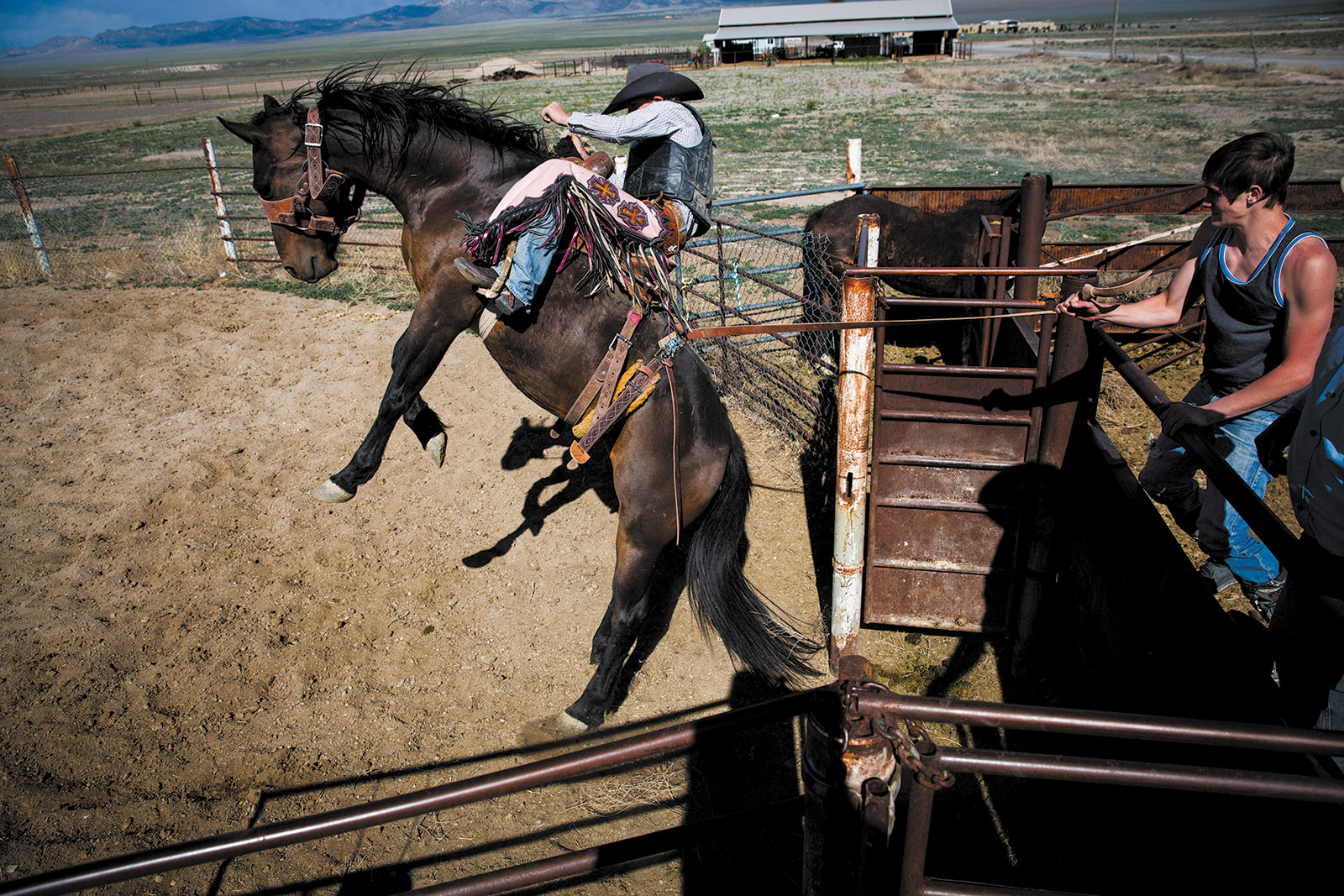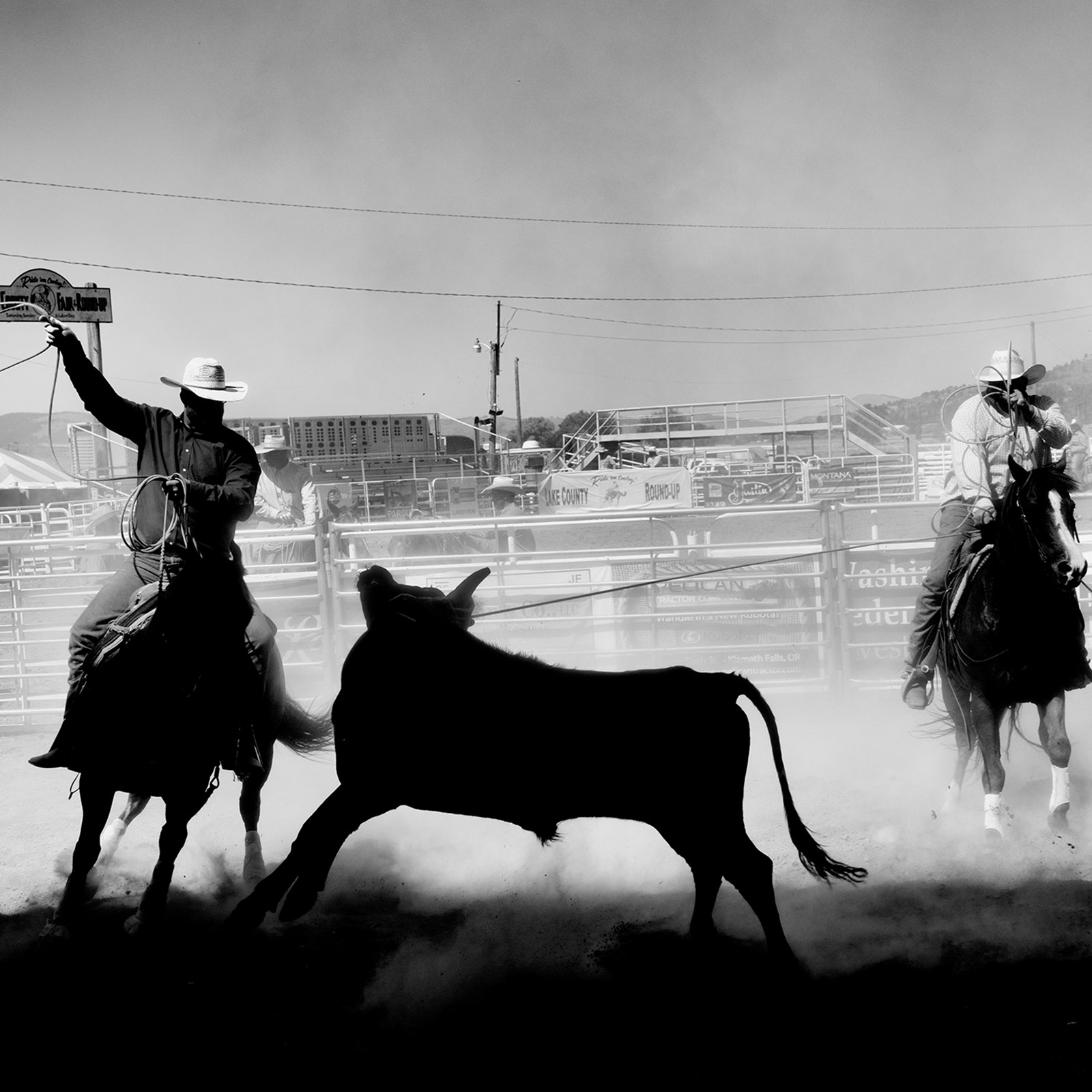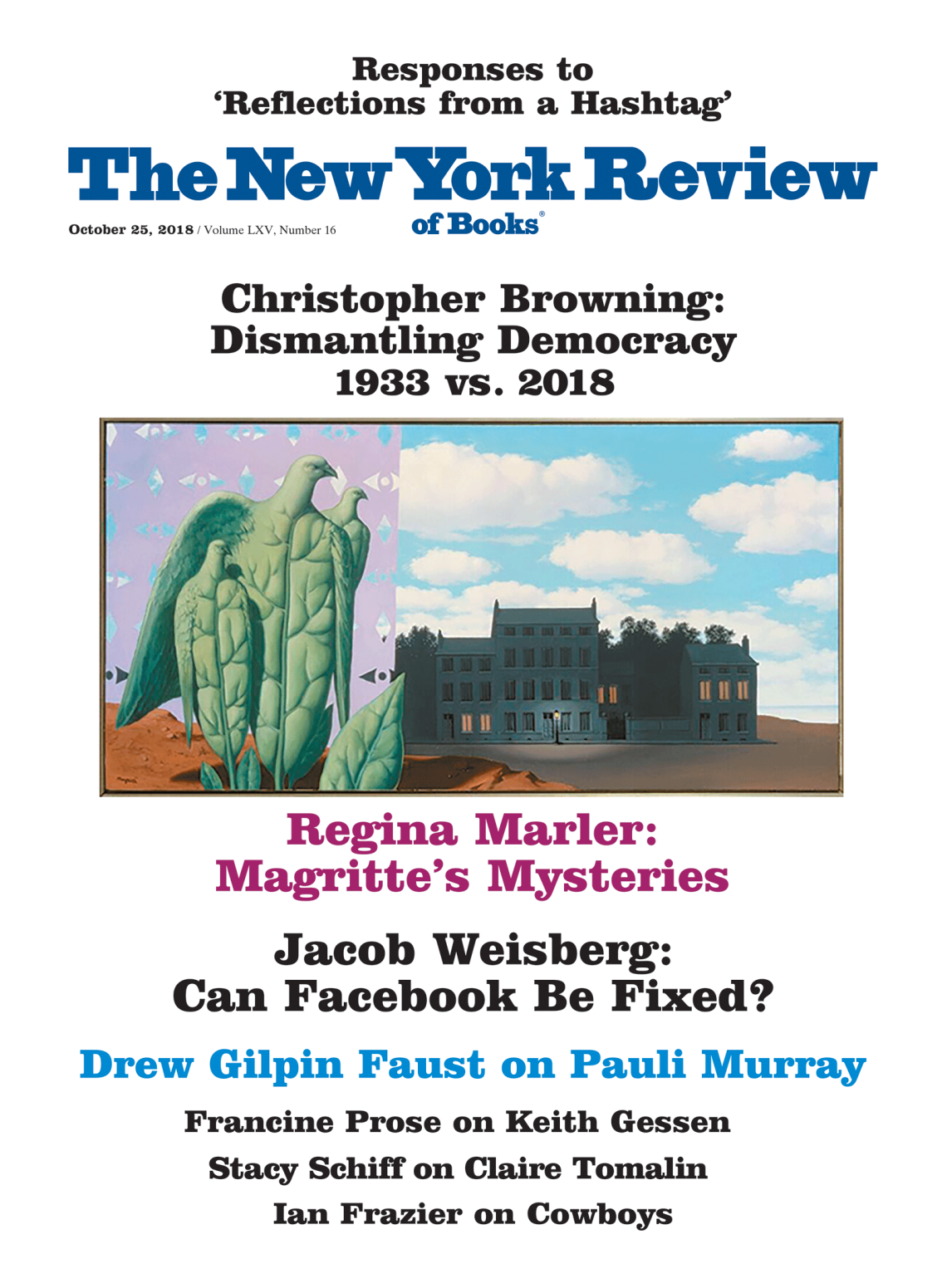Joseph Brodsky wrote, “Should the world be designated a genre, its main stylistic device would no doubt be water.” He was talking about the watery city of Venice, and about the natural affinity humans (made mostly of water) have with it. But if in the end we will all return to dust, then we have something fundamental in common with the American West, too; in the western, the country’s native genre, the main stylistic device is dust. All true westerns are dust dissipating in the rearview mirror, elegies for ways of life that constantly disappear.
The Last Cowboys: A Pioneer Family in the New West, by John Branch, goes for the elegiac mood in the title evidently out of reverence for that tradition. The book profiles a Utah family, the Wrights, who descend from Mormon pioneers and who make their living by ranching cattle and riding bucking horses (broncos, or “broncs”) in rodeos. In fact, these Wrights are not persuasive as the last of anything. At the beginning of the book we see Bill, the patriarch, and his five-year-old eldest son, Cody, survive a near-disastrous horseback encounter with a flooded river. Soon the number of Cody’s siblings has grown to twelve. By two thirds of the way through the book Cody is a grandfather (and Bill a great-grandfather), and the number of Wrights has become too large for the author to describe or the reader to keep track of. Bill says he can’t keep track of them himself.
Branch, a New York Times reporter, paints the big Utah canvas as skillfully as he drypoints the cowboy minutiae. The sun comes up; the sandstone cliffs burst forth in color; the black cattle stand “in small constellations and cast long shadows.” The day is to be a branding, in which that year’s new calves are rounded up, separated from their mothers, branded, inoculated, and ear-tagged. In camp the cowboys wake and pull on their boots. To ward off the gnats they wipe their faces with those fabric softener sheets used in clothes dryers.
Dust encircles each reluctant procession of cattle as it makes its way to the corral: “Guttural dissents carried half a mile.” Dozens of Wright family members, big and little, help out. One of the inoculations is for upper-respiratory disorders worsened by dust. At the end, the steers are castrated. Sometimes the testicles are collected to be fried and eaten, but this year they are discarded, and “the pen of the corral was littered with dirt-covered testicles. They looked like dusty pearl onions.”
Will Bill sell the ranch? It is not big enough or well situated enough for his herd to grow and keep pace with the family. Some of his land abuts Zion National Park, the third-most-popular national park in the country. Developers and conservationists and the feds hedge him round. He can get many millions if he sells—maybe enough to buy a bigger and more out-of-the-way spread elsewhere. But will his boys commit to being full-time ranchers? So far they’ve been willing participants in Bill’s operation when needed. But they all have their own lives, with day jobs and families of their own, and none seems completely in it for the long haul.
These are two of the main plot lines in the book. A third is the various Wright boys’ rodeo careers. Branch’s Times beat has been sports, and his previous book, Boy on Ice: The Life and Death of Derek Boogaard, was a prize-winning biography of a small-town Canadian boy’s ascent to fame as a professional hockey league “enforcer”—a traditional job, now less prevalent, that involved beating up opposing players for purposes of intimidation. This wrenching, bleak, exquisitely observed life resembled an elongated Alice Munro story interspersed with repeated brutal fistfights. Similar descriptions of violent rodeo rides and their consequences drive long parts of The Last Cowboys. Its ranching and rodeo plots reinforce each other. The Wright boys learn how to ride and dominate broncs on the family ranch, and the prize money they win helps sustain the ranch as it fights worsening agricultural conditions and tightening finances.
Bill rodeoed in college. Cody started riding saddle broncs professionally while still in his teens and had much success, but did not win his first World Championship until he was thirty-one. (The national finals competition, held every December in Las Vegas, is a world-encompassing event to the same extent that baseball’s World Series is.) Cody’s six younger brothers, Calvin, Alex, Jake, Jesse, Spencer, and Stewart, go on to ride broncs, though not all become pros. Cody marries in his late teens, and his oldest son, Rusty, is in the same grade at school as Becca, Cody’s youngest sister. Rusty sets up his friend, CoBurn, with his aunt. CoBurn and Becca marry; CoBurn also becomes a top saddle bronc rider, as does Rusty. Cody’s other three sons, Ryder, Stetson, and Statler, ride too, and Ryder even goes so far as to try his luck on bulls. It becomes common to see Wright family members—father, brothers/uncles, sons, and in-laws—monopolizing the leader board in the saddle bronc event at all the important rodeos.
Advertisement
These personnel developments left some questions in my mind. First, what about the girls? Cody has six sisters, but they hardly figure in the story. Barrel racing, calf roping, and the other rodeo events for women do not seem to attract them. Selinda, the eldest of his siblings, is born on page 35 and is having a baby herself, at fifteen, four pages later. She appears in the book only once more. ShaRee, Cody’s wife, mainly watches from the stands, records rides on her iPad, and keeps the household going while he is on the road from one rodeo to another. The woman we hear the most from is Evelyn, Bill’s wife, the matriarch. Of old Mormon pioneer stock herself, she deals confidently and matter-of-factly with the hard parts of being a ranch wife and rodeo mom, grandmom, and great-grandmom, and she always has an apropos saying to offer, such as “He who remains flexible will never get bent out of shape” or “People don’t care how much you know until they know how much you care.”
The book is written in a voice that could be called “Times omniscient.” Early on, we see Bill at his cow camp up on the mesa, where he stays by himself for days at a stretch while keeping track of the cattle. He gets up before the sun, starts his truck, and goes to check on his range. Walking through the brush, he now and then pinches it to test the moisture. Then, out of the blue, he speaks: “‘We usually have three times as much feed as now,’ he said with a shake of his head.” To whom does Bill say this? Well, to the Times, of course. Branch, the reporter, is accompanying him; the piece will become a six-thousand-word profile in the paper before it’s a book. True to a journalistic style, the author does not appear in the story, other than everywhere and nowhere. Keeping himself personally out is in some ways a good idea, and relaxing for the reader, who does not have the writer pressing forward his own identity and blocking the view.
Branch strictly refrains from use of the first person until the acknowledgments at the end of the book, when he thanks the Wrights for what must indeed have been a generous acceptance of him on their part. He describes the many Wright events he attended, and says:
The only family member who questioned me was Monica [the sixth of Bill and Evelyn’s thirteen children]. She approached me at a graduation party at Cody’s house one warm night before we had been introduced.
“Who are you, and what are you doing here?” she asked. I laughed at her bluntness, and we got along great from that moment on.
Branch had a major challenge in dealing with so many characters, and it left little room for including himself. The same logic of space and reader attention span may have caused him to edit out most of the women. But to me, this quote from Monica is one of the realest moments in the book. I think that had Branch put himself in the story in the plain old first person now and then, rather than staying faithful to the Times omniscient style throughout, the women in the story somehow might have become more real.
Like all rodeo cowboys, the Wrights get the hell beat out of them. Horses kick them, step on them, “lawn-dart” them headfirst into the arena dirt with a well-timed buck. Their clavicles pop out of joint, labrums are torn, leg bones break and protrude through the skin, vertebrae get crushed, heads get hit, and brains get knocked unconscious. After a few years in the arena most riders have more than a few metal rods and pins holding them together. The inescapable question, and one that Branch does not answer, is: Who is insuring these people? What must all these guys’ operations, ambulance rides, physical therapy sessions, etc., cost? (And that doesn’t include the dentistry for the teeth that get knocked out.) Some of the Wrights make six figures a year on the rodeo circuit. Does most of it go to repairs?
The book conveys a strong sense of western geography. When the Wrights’ cattle get down into the intricate windings of the canyon where they graze for part of the year it takes a lot of bushwhacking to move them out. The ranch itself, with its core twelve hundred Wright-owned acres and its twenty thousand acres of leased federal land, makes an interconnected grazing system that Bill knows how to use to the maximum. Of planners who come from elsewhere, Bill says:
Advertisement
They see these plants and this dirt and these cliffs and think this area is no good. But it’s some of the best range in the country. You just have to know how to work it.
In similar fashion, the Wrights who ride in rodeos work the West’s corners and byways. Clovis, California, and Pullayup, Washington, and Plains, Montana, and Hastings, Nebraska, and Dodge City, Kansas, and Cody, Wyoming, and Mountain Home, Idaho, all have rodeos that the Wrights go long distances to compete in, often covering a thousand-plus miles in a weekend. Their Texas rodeo circuit includes the towns or cities of Mercedes, Tyler, Amarillo, Goliad, Cave Creek, Waco, and Lubbock, among others. The bigger prize money starts in cities like Omaha, Cheyenne, Houston, Salt Lake City, Portland, and Calgary. Those last two actually overlap with Branch’s previous book, because they also have hockey arenas in which Derek Boogaard played as he traced his own small-venue saga from places like Medicine Hat, Red Deer, and Moose Jaw, down to Johnstown, Pennsylvania, and Lafayette, Louisiana. You can follow along in your Rand McNally as Branch chronicles the fly-over places with reportorial care.
Each year the roads lead to Las Vegas, site of the Wrangler National Finals Rodeo. (Wrangler Jeans is one of the companies that sponsor rodeos and major contestants like the Wrights.) In the grand entry parade, which is alphabetized by state, Utah’s cowboys and cowgirls gallop in near the end; by then the raised dust is hanging thick in the air. The event runs through ten nights and ten rides for each competitor, with a complicated set-up of judging and cumulative averages and total prize money that you don’t have to make exact sense of to get the picture.
The Wrights outshine almost everybody. In the locker room beforehand, the cowboys sit in their saddles on the floor, adjust their stirrups, roughen their chaps with wire brushes, and press chunks of black rosin into the saddle leather so the chaps will stick to it better. They discuss which kinds of baby powder—a sweat absorbent—give them the best grip on the bucking rein: “I got baby powder, but it’s not the silky soft.”
Cody suffers injuries that often keep him sidelined, but his sons take up where he (temporarily) leaves off. One year Rusty, the eldest, stars in the finals, and the next year, Ryder, the second son, places first on each of the first four nights, a feat accomplished by no other rider since Rodeo Hall of Fame cowboy Robert Etbauer did it twenty-five years earlier. Ryder, who takes home $114,000, is only eighteen. The bucking horses have names like Lunatic Fringe, Killer Bee, Urgent Delivery, Lipstick N Whiskey, and Kid Rock. Rides are described with the slow-mo precision made possible by instant replay—the horses’ crow-hopping, high-kicking, sunfishing, sidewinding, and all the rest. When the riders fall and break bones there are audible cracks.
Though ordinary-guy heroes, the Wrights are also described as a band set apart. We learn little about their competitors, and as for the family’s many fans, the ones who line up to get autographs in Las Vegas’s D Casino (another of the Wrights’ sponsors) appear as faceless throngs, or they’re mentioned with disdain as “the kinds of people who wore cowboy hats into casinos.” Throughout all, Cody and the other rodeo Wrights remain unfailingly polite and sportsmanlike, and stick to the “Yep,” “Nope,” and “Thank you kindly, ma’am” school of cowboy expressiveness. When the failure of another rider would advance them in the standings, they do not root for him to get bucked off. They never cry, or scream in pain, or brag, or gripe too much about the judges’ rulings. They win or lose, smile shyly, say little, and go home or to the hospital.
Back at the ranch, Bill has been thinking that he might not want to sell, after all. His family has been running cattle on their land for 150 years. He wonders if there’s a way for them to keep making a living on it as the modern world pushes in all around.
In 1890 the US Census Bureau declared the frontier officially closed. By then the Plains Indians had not been able to hunt buffalo for eight years or more, and cowboys who once led long-distance trail drives had lost that employment with the range now plowed up or fenced off. Rather than take up farming or selling lightning rods door-to-door, many cowboys and Indians became “Cowboys and Indians” in Wild West shows, turning the colorfulness of their former lives into entertainment. Indians who had fought Custer appeared in movies about that battle; cowboys went from riding the range to careers as Hollywood stuntmen.
When Bill decides on the ranch’s future he hits on a version of this strategy. At the end we learn that, inspired by the crowds patronizing nearby tourist attractions, he will convert a part of his ranch into a campground offering a hands-on cowboy experience and trail rides through the local scenery. In his youth he led mule trains of tourists into the Grand Canyon, so he has some experience in the hospitality trade. His rodeo-riding sons go in with him on the idea and make themselves available as celebrities, adding genuine cowboy cachet. Cody starts raising cattle dogs while two of his sons consider going into business as rodeo stock contractors. Meanwhile the younger generation keeps winning more rodeos and practicing on the mechanical bull in Cody’s yard.
A bigger plot line, perhaps beyond the scale of any book, is the drought that much of the West has been suffering for the past five or more years. Bill says he has heard that climate change is bullshit, but the short-term alteration in his land and herd is unmistakable. Each year he worries whether his cattle will be able to find water at all, and his most dependable ponds go dry. When the cattle are thirsty they don’t put on weight quickly, and he’s forced to sell them sooner. But unlike the rains, the tourists keep showing up.
Sagebrush rebels, the Cliven Bundy clan and their supporters among them, have been defying the Bureau of Land Management and the Forest Service, grazing cattle on public land and not paying the usual fees. Bill has met Bundy (a patriarch of Mormon ancestry like himself) and sympathizes with him. As all ranchers do, Bill must navigate among many competing interests of which the feds are perhaps the most intrusive. Given that the history of the West for the past two centuries has seen outside forces—the army, the railroads, agribusiness, the fossil fuel industry—crushing local power, the future may not be on the Bundys’ side. Then again, tribalism and civic fragmentation seem to be doing pretty well right now. In any case, no unified approach to climate change seems likely. Maybe the federalized, big-business West has entered its own last days.
Over and over, the West produces new “last”s. When James Fenimore Cooper published The Last of the Mohicans, almost two hundred years ago, the romantic, mythic-sounding title was too pessimistic. In fact, the Mohicans (now spelled Mahicans) survived, and today the tribe shares a reservation with the Munsee in Wisconsin, northwest of Green Bay. Not even the title The Last Cowboys can be confident that there will never be another like it, to judge from the books, movies, poems, and songs that have used versions of it before. In Western myth, the last follows the last follows the last. Utah’s Wright clan, with its energy, stoic virtues, and Abrahamic abundance of offspring, is destined to thrive, as this meticulous and affectionate book makes clear. And as for the West’s main stylistic device of dust, a glance at the bigger picture reveals that we may not yet have the slightest clue of what’s in store.




